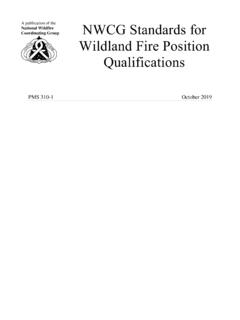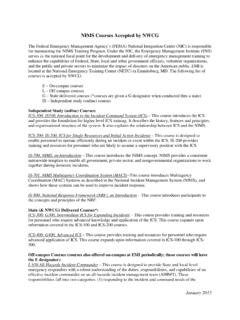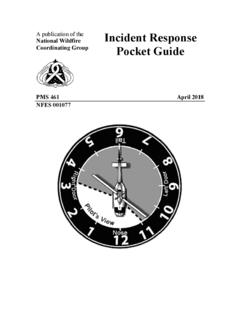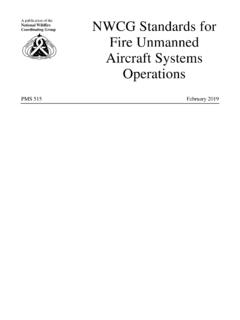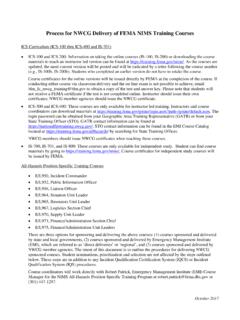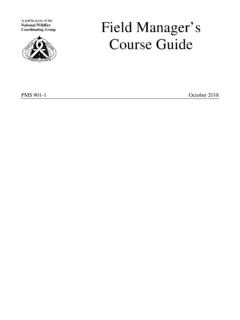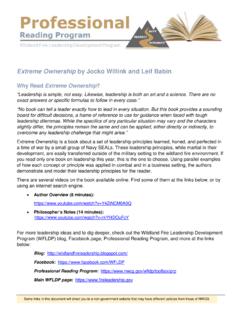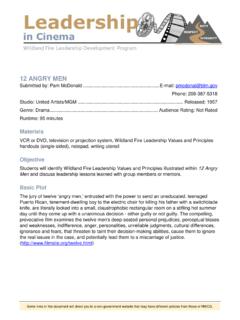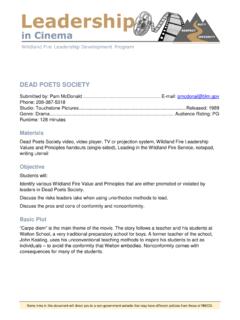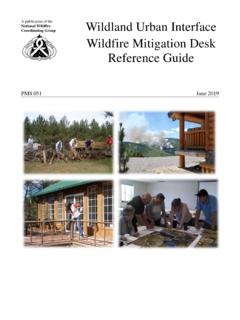Transcription of Wildland Fire Incident Management Field Guide, PMS 210
1 A publication of the national Wildfire Coordinating Group Wildland fire Incident Management Field guide PMS 210 January 2014. NFES 002943. Wildland fire Incident Management Field guide January 2014. PMS 210. NFES 002943. Sponsored for NWCG publication by the NWCG Operations and Workforce Development Committee. Comments regarding the content of this product should be directed to the Operations and Workforce Development Committee, contact and other information about this committee is located on the NWCG Web site at Questions and comments may also be emailed to This product is available electronically from the NWCG Web site at Printed copies may be ordered from the Great Basin Cache, national Interagency fire Center, Boise, ID. For ordering procedures and costs, please refer to the annual NFES Catalog Part 2: Publications posted at Previous editions: 2013. The 2013 edition replaced PMS 410-1, Fireline Handbook, NWCG. Handbook 3, March 2004.
2 The national Wildfire Coordinating Group (NWCG) has approved the contents of this product for the guidance of its member agencies and is not responsible for the interpretation or use of this information by anyone else. NWCG's intent is to specifically identify all copyrighted content used in NWCG products. All other NWCG information is in the public domain. Use of public domain information, including copying, is permitted. Use of NWCG information within another document is permitted, if NWCG information is accurately credited to the NWCG. The NWCG logo may not be used except on NWCG-authorized information. national Wildfire Coordinating Group, NWCG, . and the NWCG logo are trademarks of the national Wildfire Coordinating Group. The use of trade, firm, or corporation names or trademarks in this product is for the information and convenience of the reader and does not constitute an endorsement by the national Wildfire Coordinating Group or its member agencies of any product or service to the exclusion of others that may be suitable.
3 PREFACE. The Wildland fire Incident Management Field guide is a revision of what used to be called the Fireline Handbook, PMS 410-1. This guide has been renamed because, over time, the original purpose of the Fireline Handbook had been replaced by the Incident Response Pocket guide , PMS 461. As a result, this new guide is aimed at a different audience, and it was felt a new name was in order. Purpose The Wildland fire Incident Management Field guide states, references, or supplements Wildland fire Incident Management and operational standards established by the national Wildfire Coordinating Group (NWCG). Relationship to the Incident Response Pocket guide and Emergency Responder Field Operations guide This Field guide contains some information that is duplicated in the Incident Response Pocket guide (IRPG) and the Department of Homeland Security, Federal Emergency Management Agency (FEMA), national Incident Management system Emergency Responder Field Operating guide (ERFOG), but the documents have different purposes and user groups.
4 This Field guide is the standard NWCG Incident Management reference guide . The IRPG is the Wildland fire job aid and training reference for operational personnel from Firefighter Type 2 through Division Supervisor and Initial Attack/Extended Attack Incident Commander, and is primarily an initial responder's tool. The ERFOG provides guidance designed to assist emergency response personnel in the use of the national Incident Management system ( nims ) Incident Command system (ICS) during Incident operations and is primarily a Command and General Staff tool. Revision Process This Field guide will be revised every 5 years. To recommend changes to the document, contact your agency representative on the Operations and Workforce Development Committee (OWDC). Information about this committee is located on the NWCG Web site at The Field guide is available electronically and is formatted for printing on standard 8 x 11-inch paper. Wildland fire Incident Management Field guide 5.
5 6 Wildland fire Incident Management Field guide TABLE OF CONTENTS. PREFACE .. 5. 5. Relationship to the Incident Response Pocket guide and Emergency Responder Field Operations guide .. 5. Revision Process .. 5. TABLE OF CONTENTS .. 7. CHAPTER 1 FIREFIGHTING 13. Risk Management .. 13. Tenets of a High Reliability Organization .. 13. Wildland fire Safety Culture .. 14. Wildland fire Safety Principles .. 15. Clothing and Personal Protective Equipment .. 15. Fatigue Work and 16. Nutrition and Hydration .. 16. Driving Limitations .. 17. Smoke Impairment of Roads: Assessment and Response .. 17. Carbon Monoxide Poisoning .. 19. Injury and Fatality Procedures .. 21. Serious Injury .. 21. Fatality .. 21. Burn Injury Procedures .. 22. Night Operations .. 23. Personnel Transportation .. 23. Firing Equipment .. 23. Chain 24. Incident -Generated Hazmat .. 24. Media Access Guidelines .. 25. General 25. Guidelines .. 25. Safety Responsibilities of Wildland fire Supervisors.
6 27. General Responsibilities .. 27. CHAPTER 2 OPERATIONAL GUIDES .. 29. Initial Attack .. 29. Wildland fire Incident Management Field guide 7. Definition of Initial 29. Characteristics of an Initial Attack Incident (Type 4 And Type 5 Incidents) .. 29. Example of Initial Attack Organization (Type 4 Incident ) .. 30. Duties of an Initial Attack Incident Commander .. 30. Assessing Incident Progress .. 32. Updating Incident Status .. 32. fire Suppression Strategies .. 33. Initial Attack Safety Checklist .. 34. Extended Attack .. 35. Definition of Extended Attack .. 35. Characteristics of an Extended Attack Incident .. 35. Example of an Extended Attack 36. Change From an Initial Attack Incident to an Extended Attack Incident .. 36. Control or Transfer to Type 2 Incident .. 38. Extended Attack Safety Checklist .. 39. Large fire Management Teams .. 40. Type 2 Organization .. 40. Type 1 Organization .. 40. Organization Chart for Type 1 and Type 2 Incidents.
7 41. Area Command .. 41. Unified Command .. 41. Transfer of Command .. 42. Incident Commander Briefing .. 42. Incident Commander's Checklist .. 43. Agency Administrator(s)' Responsibility for the Transfer of Command and Release of Incident Management Teams .. 43. Transfer of Authority .. 44. Agency Administrator Briefing .. 44. Release of an Incident Management Team .. 45. Urban Interface .. 46. Wildland /Urban Interface Watch Out Situations .. 46. Identification of Reduced-Risk Structures and Communities .. 46. Structure Triage Guidelines .. 47. Structure Assessment Checklist (if Time Permits) .. 48. Structure Protection Guidelines .. 50. 8 Wildland fire Incident Management Field guide CHAPTER 3 POSITION RESPONSIBILITIES .. 53. Command and General Staff .. 53. Organization Chart .. 53. Position Checklists .. 54. Operations .. 58. Organization Chart .. 58. Position Checklists .. 59. Air Operations .. 64. Position Checklists .. 66. Helispot Location and Construction.
8 74. Principles of Retardant Application .. 75. Planning .. 76. Organization Chart .. 76. Position Checklists .. 77. Planning Process .. 89. 89. Logistics .. 90. Organization Chart .. 90. Position Checklists .. 91. Logistics 99. Factors to Consider When Locating and Laying Out an Incident Base or Camp .. 101. 102. Organization Chart .. 102. Position Checklists .. 103. CHAPTER 4 REFERENCE .. 109. Portable Pumps and Hydraulics .. 109. Formula for Determining Pump Pressure .. 109. Reminders for Using Portable Pumps and Hose Lays .. 110. Drafting Guidelines .. 110. Expected Output of Commonly Used Portable Pumps at Sea Level .. 110. General Rules for Fireline Hydraulics .. 111. Friction Loss by Hose Size and Type .. 112. Pump Pressures for 50-psi Nozzle 113. Pump Pressures for 50-psi Nozzle 114. Wildland fire Incident Management Field guide 9. Pump Pressures for 50-psi Nozzle Pressure (Continued) .. 115. Foam .. 116. Foam Use .. 116. Foam Mixture Rates.
9 116. Foam for Direct Attack .. 117. Foam for Indirect Attack .. 117. Foam for Mop Up .. 117. Foam for Exposure Protection .. 117. Foam Safety .. 118. Use of Fireline Explosives .. 118. Advantages .. 118. Disadvantages .. 118. Hazmat Checklist for Incident Base 119. Use of Inmate Crews .. 120. Production Tables .. 121. Sustained Line Production Rates of 20-Person Crews in Feet per Hour* .. 121. Sustained Line Production Rates of 20-Person Crews in Feet per Hour* .. 121. Sustained Line Production Rates of 20-Person Crews in Chains per Hour* .. 122. Sustained Line Production Rates of 20-Person Crews in Chains per Hour* .. 122. Line Production Rates for Initial Action by Hand Crews in Chains per Person per Hour . 123. Line Production Rates for Initial Action by Engine Crews in Chains per Crew per Hour . 124. Fireline Explosives Production Comparisons .. 125. Dozer Fireline Construction Rates (Single Pass) in Chains per Hour .. 126. Dozer Fireline Construction Rates (Single Pass) in Chains Per Hour (Continued).
10 127. Tractor Plow Fireline Production Rates in Chains per Hour .. 128. Interagency Crew Qualifications and Equipment Standards .. 129. Minimum Crew Standards for national Mobilization .. 129. NWCG Engine and Water Tender Typing (Minimum Requirements) .. 130. Common Additional Needs for Engines and Tenders (Request As Needed) .. 131. Air Tankers .. 132. Helicopters .. 132. Other References .. 133. Clear-Text guide .. 133. Clear-Text guide (Continued) .. 134. 10 Wildland fire Incident Management Field guide ICS Map Display 135. ICS Map Display Symbols (Continued) .. 136. Conversion Factors for Map Scale .. 138. Formula for Area and Circumference of a Circle .. 138. Acreage Determination Factors .. 139. Conversion Factors .. 142. Conversion Factors (Continued) .. 143. Incident Command system Forms .. 144. Resource Status Card .. 145. Distances and Formulas for Estimating fire Size .. 146. What the Color and Column of Smoke May Mean.
